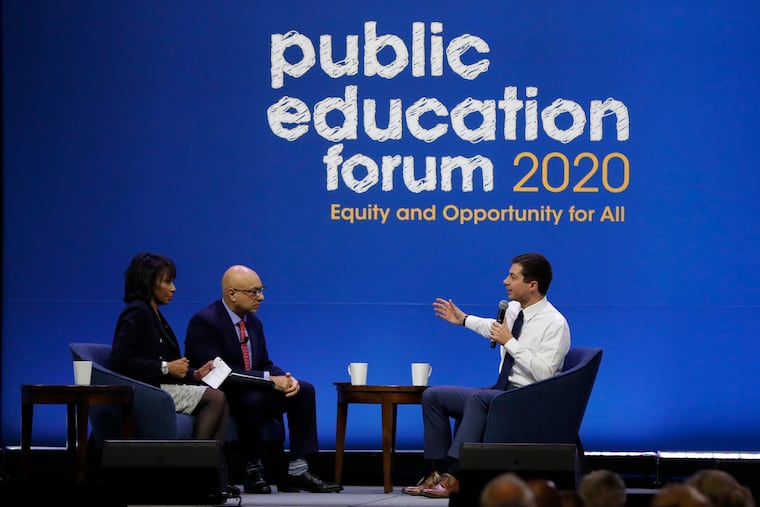Public education’s problems won’t be fixed with more funding | Opinion
Over the course of four decades, we have just about doubled spending on public education.

For decades, teachers unions, and the politicians they support have been telling voters that the key to improving public education is to spend more money. At the beginning there wasn’t much evidence to go on, but it seemed to sound right to most people. What little data existed indicated that private schools educated students at a lower per-pupil cost than public schools while achieving better outcomes (as measured by standardized tests).
There were, of course, reasonable rejoinders to these results. Because higher income households can more readily afford private school, and because children who grow up in higher income households tend to perform better academically, the results may have been simply the result of selectivity bias: private schools performed better because better students ended up in private schools.
But as the decades rolled by, data accumulated to the point where we no longer have to compare private to public schools. We can compare public schools in years of less spending to public schools in years of more spending. Shockingly, though, now that we have solid data, spending proponents are not only ignoring the data, they are distorting it.
Last week, The Inquirer cited Sarah Lawrence College labor historian Priscilla Murolo discussing the future of unions in public education, which has seen “drastic cuts to funding over the last decade.” The story was later revised to say that “despite increases to education funding … costs are outpacing those increases for many school districts.” Yet, at least on average across the country, this isn’t true either.
Two weeks ago, the dean of the University of Virginia’s school of education made a similar claim in the Washington Post that, adjusted for inflation, government funding for public education has declined since the 1980s. The Washington Post story was corrected to acknowledge that these claims aren’t even close to the truth.
According to the National Center for Education Statistics, from 1980 to 2016 (the last year for which NCES reports data), inflation-adjusted per-pupil spending in public schools increased 91%. Over the course of four decades, we have just about doubled spending on public education. Per-student. After inflation. And that’s not because we have built campuses that rival those of small colleges (though in many cases, we have). Per-pupil, inflation-adjusted spending excluding physical plant (e.g. site maintenance) and equipment is up 86%.
And what has this increased spending on public education given us? Dropout rates are down versus 1980, but overall unchanged from the mid-1980s. High school graduation rates remained unchanged from 1980 until the early 2000s, when they started edging up. But this change coincided with the passage of the No Child Left Behind Act, not with a clear change in spending patterns.
» READ MORE: The segregating effects of school choice policies | Opinion
All of this raises two questions that Governor Tom Wolf and like-minded politicians refuse to ask. First, if massive increases in public education spending haven’t already resulted in massive increases in educational quality, then why should we expect anything good to come of even more massive increases, like the $1 billion the governor recently touted as “historic investments?” Second, if massive increases in public education spending don’t give us massive increases in educational quality, then what would?
For answers, one might look to virtually anything for which Americans voluntarily spend their hard-earned money. Massive increases in the quality of electronics, food, cars, and most everything else Americans buy is fueled by the fact that each American gets to choose where to spend his dollars. When providers deliver what people want, people reward them with more dollars. When providers don’t deliver, people withhold their dollars.
» READ MORE: School choice is not the source of education’s ills in Philly or elsewhere | Opinion
Here we see a stark truth. When politicians are the ones controlling the dollars, providers — in this case the public school apparatus — deliver what politicians want. And the two things politicians want more than anything else are votes and campaign contributions. The Pennsylvania teachers union gave $1.5 million to Governor Wolf’s 2018 campaign. In return, Wolf delivered what the union wants: a veto of legislation that would have expanded school choice in Pennsylvania.
If politicians really wanted public education to be better in the Keystone State, they would put the power to choose firmly where it belongs: in the hands of parents. That they refuse to do this lays bare the fact of the matter: Politicians like Governor Wolf care less about educational outcomes than they do keeping union cronies happy. And until parents demand better, our public schools won’t improve.
They will just become more expensive.
Antony Davies is associate professor of economics at Duquesne University. James R. Harrigan is managing director of the Center for the Philosophy of Freedom at the University of Arizona. They host the weekly podcast, Words & Numbers.